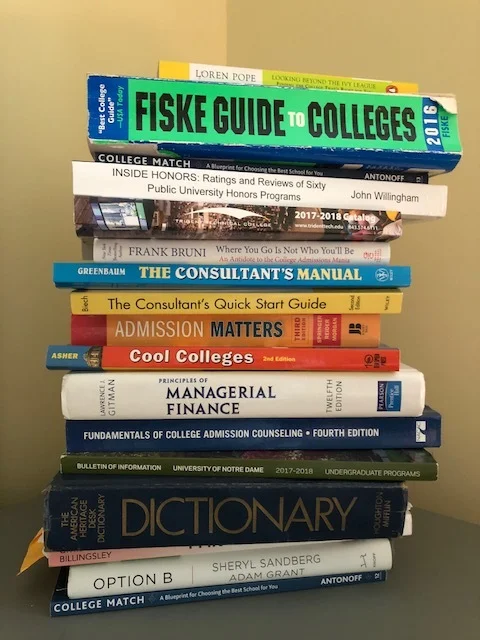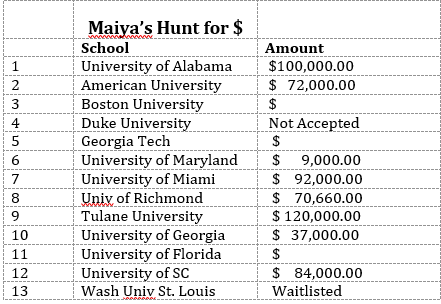Where’s the Money? The Hunt for Scholarship $
With total Cost of Attendance at some private universities now breaking through the $70,000 level, parents are often understandably exasperated by the prospects of paying for college. Many families that I work with often have household income and asset levels that exceed the financial aid cutoffs, but the dent of a $50,000-$70,000 annual expense would require a major realignment of the overall family budget. Multiply that by several children, and the full cost of attendance to private or out-of–state college just becomes overwhelming. In-state public universities often provide the least costly college experience, but there are other options to explore if your child is hoping for an out-of-state college experience.
Merit scholarship money does exist. The unfortunate thing is that it is not readily chronicled. You might think that the Common Application or Coalition Application systems might have by now included detailed merit scholarship information for each college to help navigate prospects for securing merit money, but sadly that doesn’t exist. Even on college websites, merit scholarship details are murky when it comes to how many scholarships are available, characteristics of likely scholarship winners, and total amount of merit scholarships granted. Additionally, merit scholarship applications vary by college with some schools using the common application platforms for automatic scholarship screening, while other schools require separate applications and or essays. All of this has fueled the boom in independent college counselor assistance. While my intention with this blog article is primarily to advocate on behalf of students and families for all colleges to adopt greater transparency and efficiency with scholarship data and processes, I also want to highlight a few options in the meantime.
Out-of-State Automatic Merit Scholarships
Out-of-state automatic merit scholarships offer the easiest way for students to attain a goal of studying in another state at a reasonable price. That said, this opportunity is largely reserved for strong standardized test scorers. In some cases, for top test scorers, it actually can be cheaper to study at an out of state public university that offers automatic merit scholarships than to attend an in-state public university! Below I highlight the various colleges offering automatic merit scholarships along with website links which detail the eligibility requirements as each college sets their own criteria and scholarship amounts.
The University of Alabama was a pioneer in recruiting out-of-state top students using this type of scholarship program. Today more than 40% of freshmen have an ACT of 30 or higher at University of Alabama and since 2014, there are more out-of-state students than resident students.
University of Alabama
https://scholarships.ua.edu/types/out-of-state.php
University of Tennessee
https://onestop.utk.edu/scholarships/volunteer/
University of Arizona
(Wildcat Excellence Awards)
https://financialaid.arizona.edu/types-aid/scholarships/scholarships-0
University of Mississippi
(Academic Excellence)
https://finaid.olemiss.edu/scholarships/#12
Texas Tech University
(Presidential Scholarship)
http://www.depts.ttu.edu/scholarships/FreshmanPresidentialLevels.php
Louisiana State University
Regional Compacts
A regional compact for most states within the Southeast provides a further opportunity for students with particular major interests that are not available within their in-state college offerings. The specific opportunities for SC students can be found at this link on the Southern Regional Education Board’s Academic Common Market website:
http://home.sreb.org/acm/SearchResult.aspx?state=SC
There are four regional compacts across the US operating with differing stipulations. The New England compact operates similar to the Southeastern compact and applies to majors that can not be pursued in the student’s home state. The Midwest compact allows students from Illinois, Indiana, Kansas, Michigan, Minnesota, Missouri, Nebraska, North Dakota and Wisconsin to receive tuition discounts at more than 100 participating colleges and universities. Public colleges in the program agree to charge eligible students no more than 150% of the school’s in-state tuition, and participating private colleges cut 10% off the cost of tuition for students from the region. The Western compact program offers eligible students from 15 states (Alaska, Arizona, California, Colorado, Hawaii, Idaho, Montana, Nevada, New Mexico, North Dakota, Oregon, South Dakota, Utah, Washington and Wyoming) 150% of the in-state tuition rate at participating public colleges across the region. Neither the Midwestern nor the Western regional program require that students pursue a major not available in their home state, but each program does allow colleges and universities to add their own restrictions.
Plain Old-fashion Research: Example Maiya
Until colleges unite in improving transparency for merit scholarship information, plan old-fashion research is perhaps the best way to seek out merit scholarships. Generally strong students will often need to “drop down a level” in academic prestige to gain a large merit scholarship. This application cycle, we had a College Sage student who specifically hoped to attend college out-of-state. We made a very intentional list of 13 colleges to target for merit scholarships at the type of college she wanted and the geographic circle her parents would agree to. Maiya racked up $584,660 of college scholarship options for her four years. In the end, she decided that Tulane offered her both the most money and best fit for her upcoming college experience.
It should be worth noting that media like the recent Wall Street Journal article entitled Prizes for Everyone: How Colleges Use Scholarships to Lure Students (April 17, 2018) can make it seem easier than it really is to score a major scholarship. First, most scholarships go to the very top applicants to a college. Second, finding “a scholarship” and “a significant scholarship” are two very different things. A $5,000 annual scholarship at a college with a $70,000 cost of attendance doesn’t make it any more realistic for most students. While a $30,000 annual scholarship can put that college in range. Full ride scholarships like the UNC Morehead and UVA Jefferson that requires your high school nomination are great options for the top students, but keep in mind that even then, the competition is fierce. As an example, the Jefferson has about 2,000 nominees for less than 40 scholarships. That’s less than 2% likelihood.
The College Sage had the opportunity to track all student scholarships last year at one of the nation’s top high schools. Less than 10% of students received a scholarship award above $100,000. Where were the major scholarships found? Military scholarships as well as: UVA (Jefferson Scholarship), University of Alabama, University of Georgia, Tulane, Furman, Clemson, Wake Forest, Hollins, Rhodes, Wofford, and SCAD.
A major scholarship generally requires a top student academic profile, excellent teacher and counselor recommendations, a strong application, strategic college targeting, and a healthy does of luck.
For a realistic assessment of scholarship opportunities and a creative lens on how to enhance affordability, contact thecollegesage@gmail.com.



















